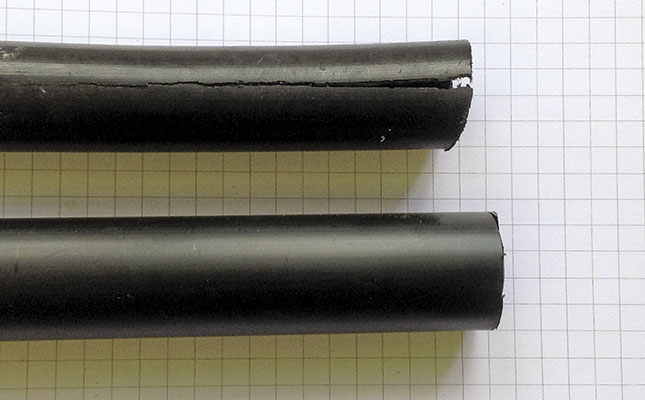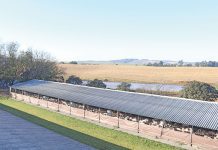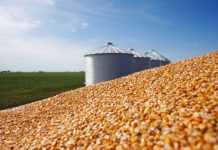
The kind of irrigation pipes you choose can affect the cost of your irrigation system and its long-term performance. Since SABS-approved (ISO 4427) black polyethylene pipe is expensive, small-scale farmers might be tempted to go for cheaper utility piping, which some agents claim is ‘as good as the SABS kind’. However, learning from my own experience on a small-scale operation, this is where you need to stop and think.
READ: Agri schools: time to reassess
Irrigation pipes assessed
Reprocessed material
Polyethylene utility piping is cheaper because it’s made from reprocessed material, whereas the ISO 4427 standard specifies that virgin material be used. Reprocessed material comes from various sources, some of which are not suitable for the manufacture of irrigation pipes. Every time the material is processed, some of its properties are degraded. The ISO 4427 standard requires that a pipe should contain enough carbon black and other stabilisers to last for 50 years at its working pressure. Utility pipe rarely has such a guarantee.
Claims that ‘3 bar pipe can take up to 12 bars before bursting’ are meaningless when you consider it’s the long-term performance of the pipe under pressure and solar exposure that’s important. Plastic materials creep under load, and even low pressure loads over a few hundred hours can induce failure.
Cracks and defects
Above are pictures of a utility pipe that has been in service above ground for four years.
A. The surface has started to degrade to the point where the pipe is failing due to a longitudinal crack with no swelling or ballooning out of the pipe diameter. This is a ‘brittle fracture’.
B. This shows a surface defect – the score line from extrusion.
C. Wall thickness – note inclusions and grit in the material.

Using utility pipe
If you have to use utility pipe, you can extend its life by burying it and avoiding point – or concentrated – loads from backfill stones that can damage the pipe, and by using lower pressure. Many of the failures I’ve recorded on my own buried lines are due to point load from poorly selected backfill, or damage to pipes buried too shallowly.
On exposed lines, failures are related to brittleness due to solar exposure. Buried utility pipe, used at the designated pressures, should last at least 15 years. Assuming it’s not chewed by rodents or damaged by traffic, exposed pipe should last at least 10 years.
Choosing the irrigation pipes
When it comes to selecting pipe without doing sophisticated tests, the following criteria need to be taken into account (although these don’t guarantee performance):
- Wall thickness: with ISO 4427 pipes, tables provide a guide for the minimum wall thickness of a particular class of pipe. For example, a 50mm pipe, classed as a 6 bar working pressure pipe, made from three different grades of virgin polyethylene, will have the following wall thicknesses – PE 63: 3mm minimum; 3,4mm maximum (these figures aren’t specifically listed in the ISO 4427 table); PE 80: 2,4mm; 2,8mm; and PE 100: 2mm; 2,3mm. In utility pipes, the wall thickness should be increased, but this can lead to complications when insert fittings are used. With increased thickness, the insert fit can be tight and the material stressed. The result is often failure where the pipe deforms to accommodate the fitting.
- Distribution: make sure the wall thickness is even and the pipe is not thinner in some places. This will illustrate the care with which the manufacturer has made the pipe.
- General appearance: the pipe should be free of scores and grooves and have a smooth interior. A shiny or high gloss surface may indicate excessive processing temperatures and point to possible future failures. The pipe must be black, not grey, as this shows that sufficient carbon black has been added. (Carbon black is a stabiliser that helps protect the pipe against solar exposure.)
- Odour: a bad odour inside the pipe indicates poor cleaning of recycled materials. As a general rule, a bad smell equals a bad pipe. Pipe made from recycled house materials is generally, but not always, better than pipe made from recycling from a waste dump or undefined sources.
Finally, when buying more than just a few metres of utility pipe, insist on some form of performance guarantee or a letter of conformance to a performance specification from the manufacturer. Alternatively, the SABS or ISO mark will define the quality of the pipe, so be sure this is printed on the pipe. Pipe manufacturers belonging to the South African Plastics Pipe Manufacturers Association (SAPPMA) have an additional SAPPMA mark on the pipe to indicate conformance to the product specification.
Aside from being a small-scale farmer, Bernard Reeksting is an expert in the field of polymer processing. Contact him on 012 841 2618 or 082 569 4062.
This article was originally published in the 22 February 2013 issue of Farmers Weekly.













